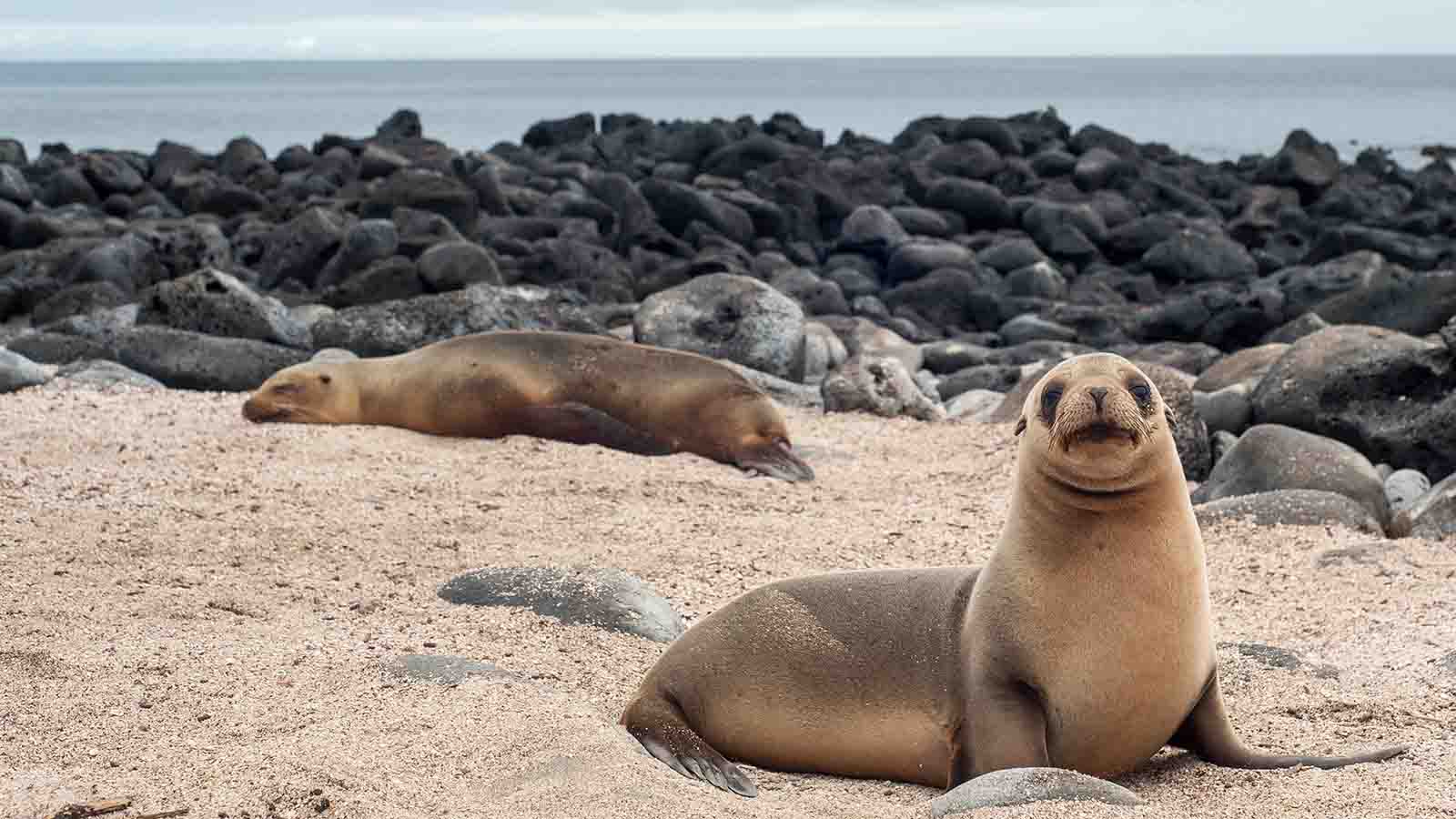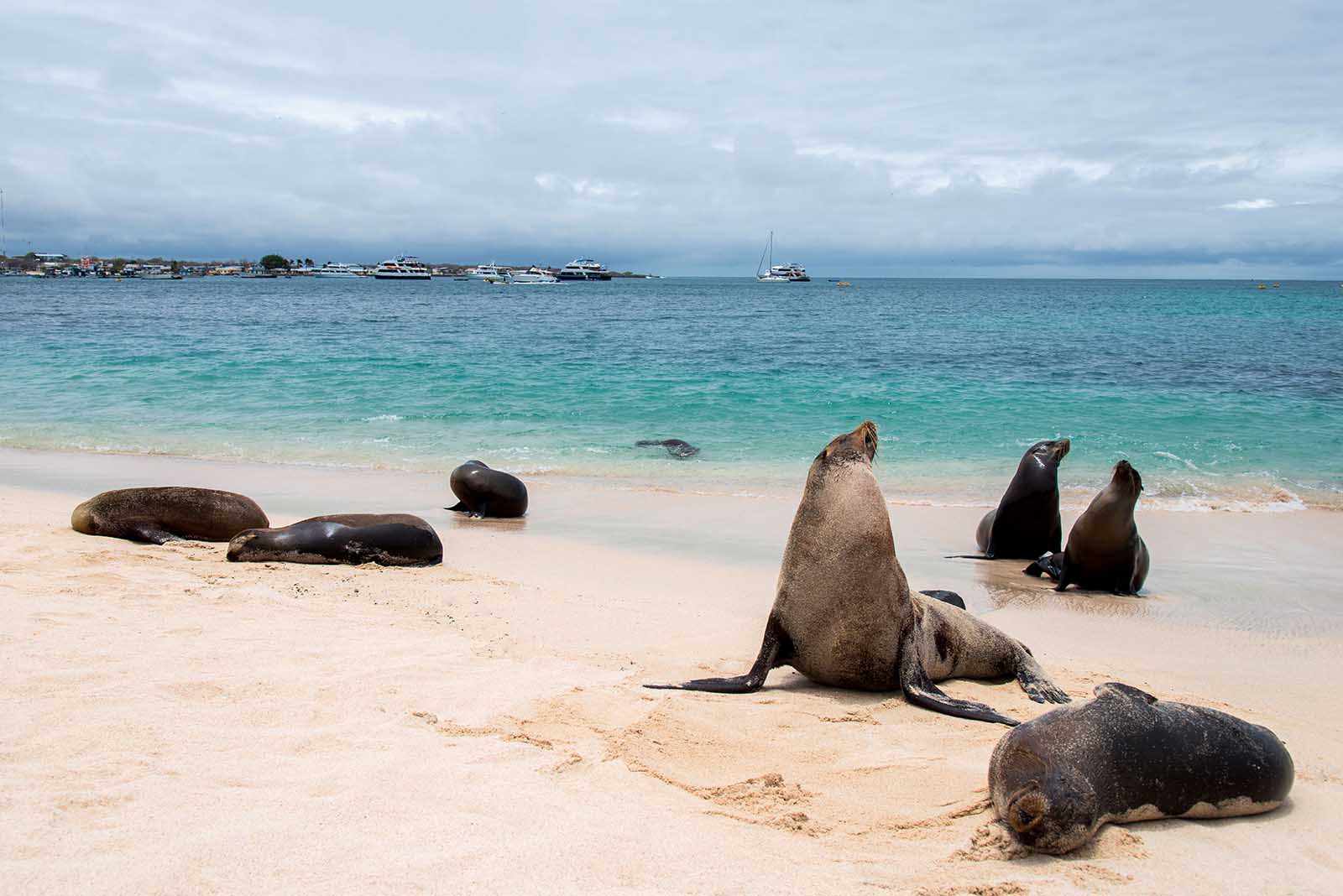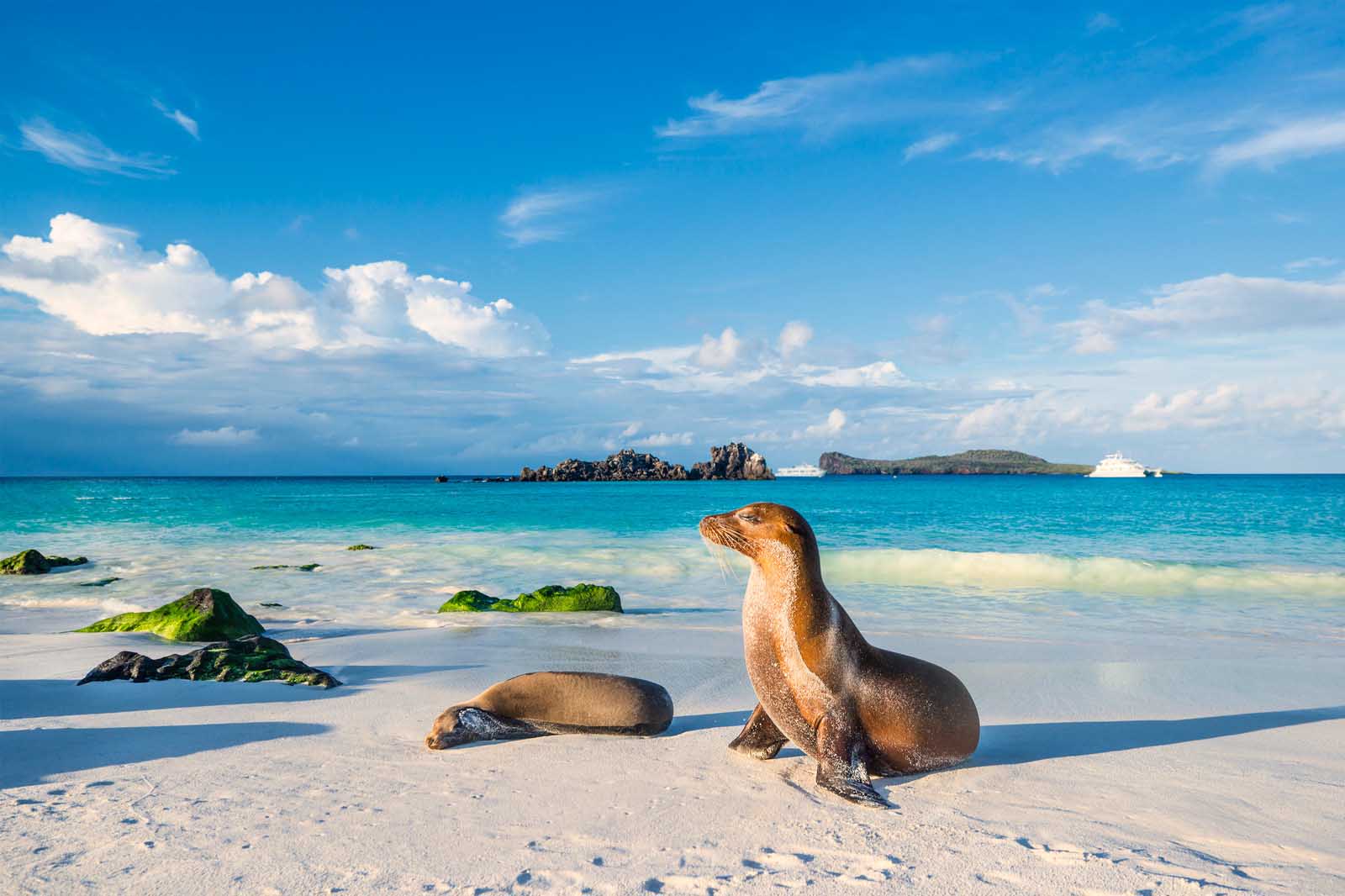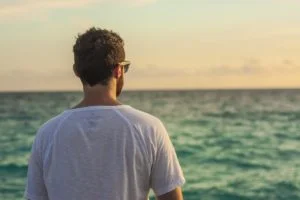
Exploring the Enigmatic Galapagos Sea Lions: 9 Fascinating Insights | Travel Blog
Galapagos sea lions are undeniably one of nature's most captivating creatures. In the crystal-clear waters surrounding the Galapagos Islands, these aquatic wonders resemble real-life mermaids, moving with unparalleled grace and agility. However, when they venture onto the land, their demeanor takes a different turn. These marine mammals, though charming, can be quite territorial, especially during mating season, adding an element of danger to their allure. In this in-depth exploration of Galapagos sea lions, we'll dive deeper into the fascinating world of these charismatic beings, shedding light on their behavior, habits, and the unique features that make them a beloved species among animal lovers.
Table of content
The Basics of Galapagos Sea Lions
Sea Lions: The Adorable Yet Complex Species
- A Wacky Naming System
- Feeding Frenzy: The Voracious Appetite of Galapagos Sea Lions
- Sardine Delights: A Taste of Galapagos Sea Lions' Diet
- Diving to the Abyss: Galapagos Sea Lions' Incredible Deep Diving Skills
- Breath-Holding Champions: Galapagos Sea Lions'
- Galapagos Sea Lion Gender Guide: Size Matters!
- The Galapagos Sea Lion Is Endangered
- Galapagos Sea Lions: Nature's Bodybuilders
- Sealanguage: Mother-Pup Communication in Galapagos Sea Lions
The Conservation of Galapagos Sea Lions
The Basics of Galapagos Sea Lions
Latin Name: ZALOPHUS WOLLEBAEKI
Size: 59-98 Inches (150-250 cm)
Weight: 110-880 lb (50-400 kg), Relatively smaller than their Californian Cousins
Color: A beautiful golden sheen complements their brown and black coat
Uniqueness: Galapagos Sea Lions are endemic to the Galapagos Islands, making them a symbol of this pristine ecosystem.
Sea Lions: The Adorable Yet Complex Species
Galapagos sea lions captivate observers with their captivating charm and intriguing habits. While watching these creatures, you might notice their striking resemblance to adorable, albeit lazy, dogs. However, there's much more to discover about these enchanting beings. Let's delve into nine cool Galapagos sea lion facts that will leave any animal lover in awe.
1. A Wacky Naming System
In the English-speaking world, these creatures are referred to as "sea lions," a nod to their resemblance to their terrestrial counterparts. In Spanish, Galapagos sea lions bear the name "lobos del mar," which translates to "wolves of the sea." It's a testament to the diverse and often amusing nomenclature surrounding these marine mammals. Within their species, a male is known as a "bull," a female as a "cow," and a baby as a "pup." Lions, wolves, cattle, and dogs all coexist within this unique species.

2. Feeding Frenzy: The Voracious Appetite of Galapagos Sea Lions
Galapagos sea lions have insatiable appetites. Males can consume an astonishing 30-45 lbs (13-20 kg) of food each day, while females are slightly more moderate at 15-25 lbs (6-11 kg). To put it in perspective, that's like a person devouring 63 to 94 Big Macs every day, based on an average burger weight of 7.6 oz.
3. Sardine Delights: A Taste of Galapagos Sea Lions' Diet
The diet of Galapagos sea lions primarily consists of sardines, making up around 70% of their meals. While some people may have an affinity for sardines, the constant repetition of the word "sardines" can render it quite strange. Yet, for sea lions, these small fish are a delicacy.
4. Diving to the Abyss: Galapagos Sea Lions' Incredible Deep Diving Skills
One of the remarkable feats of Galapagos sea lions is their ability to dive deep into the ocean. They typically average depths of about 98-196 ft (30-60 m), with exceptional individuals reaching down to 328 ft (100 m). To provide some context, even equipped with scuba gear and oxygen tanks, humans tend to refrain from venturing deeper than 100 ft (30 m). Beyond this depth, they require special gas mixtures to prevent nitrogen narcosis, which can lead to symptoms akin to inebriation. The sea lions' ability to free-dive to such depths is nothing short of astounding.

5. Breath-Holding Champions: Galapagos Sea Lions'
Astonishing Ability to Stay Submerged Galapagos sea lions are masters of breath-holding, capable of remaining submerged for up to 20 minutes. This impressive feat puts the human ability to shame, as brain damage starts to set in after just 4 minutes without oxygen. Sea lions are truly remarkable in their aquatic adaptations.
6. Galapagos Sea Lion Gender Guide: Size Matters!
Discerning the difference between male and female Galapagos sea lions is relatively simple. Males are notably larger, sometimes two to three times the size of females. Additionally, males develop a conspicuous bump on their foreheads as they reach the sea lion equivalent of puberty, making the distinction even more evident.

7. The Galapagos Sea Lion Is Endangered
While these creatures are enchanting and resilient, it's essential to recognize the critical need for their conservation. Unfortunately, the Galapagos sea lion is an endangered species, signifying that they are at risk of becoming extinct. Currently, only an estimated 20,000 to 50,000 Galapagos sea lions remain, underscoring the urgency of protective measures.
8. Galapagos Sea Lions: Nature's Bodybuilders
The physical differences between male and female Galapagos sea lions extend beyond size. Males boast thick, strong necks, chests, and shoulders, while their abdomen remains small and slender. In contrast, females have longer, sleeker necks and a thick torso. This distinctiveness adds to the unique charm of these marine mammals.
9. Sealanguage: Mother-Pup Communication in Galapagos Sea Lions
Communication among sea lions, especially between mothers and pups, relies heavily on a vocal exchange. As soon as they are born, a mother sea lion becomes attuned to her pup's unique bark, enabling her to locate the young one amidst a crowd of 30 or more barking sea lions. Mothers also use their barks as a warning system, alerting their pups to approaching dangers, such as sharks.

Are Galapagos Sea Lions Dangerous?
The juxtaposition of the sweet appearance of Galapagos sea lions with their potential danger is intriguing. These marine mammals can indeed pose a threat, particularly the males during mating season. Their territorial instincts might lead them to perceive humans as intruders, and conflicts can turn violent. However, with appropriate respect and adherence to safety guidelines, interactions with these majestic creatures can be awe-inspiring. While Galapagos sea lions can be dangerous, especially if provoked or approached recklessly, they generally don't attack people without reason. Following the guidance of knowledgeable guides ensures safe encounters with these captivating creatures.
The Conservation of Galapagos Sea Lions
The enchantment of Galapagos sea lions is undeniable, but their existence is under threat. The conservation of these magnificent creatures is a pressing concern. Understanding the challenges they face is crucial for preserving their future.
Environmental Pressures
One of the primary challenges facing Galapagos sea lions is environmental change. Climate change, including rising sea temperatures and the disruption of local ecosystems, affects the availability of the sea lions' primary food source, sardines. Changes in sea temperature can lead to alterations in fish migration patterns, making it more difficult for sea lions to find adequate nourishment.

Overfishing
Overfishing in the Galapagos Islands is another issue that indirectly impacts sea lions. The depletion of fish stocks due to overfishing can reduce the sea lions' access to food. Local efforts to establish marine reserves and regulate fishing activities aim to address this problem, but it remains a significant concern. Human Interaction Tourism is vital to the Galapagos Islands, but it also introduces challenges. Human presence, while often respectful, can at times disrupt sea lion habitats. It is essential for visitors to adhere to responsible wildlife viewing practices and guidelines established by the Galapagos National Park to minimize the impact on these creatures.
Conservation Efforts
Efforts to protect Galapagos sea lions are underway. Local organizations and international partners are actively engaged in research, monitoring, and conservation projects to safeguard these creatures. Education and awareness programs inform the public about the importance of preserving the Galapagos environment and its unique inhabitants.
The Galapagos Sea Lion Experience
Observing Galapagos sea lions in their natural habitat is a unique and unforgettable experience. Visitors to the Galapagos Islands have the opportunity to witness these magnificent creatures up close and learn about their behavior and habitat.
Snorkeling and Diving
One of the most immersive ways to encounter Galapagos sea lions is through snorkeling and diving. These playful marine mammals often engage with snorkelers, creating memorable and thrilling underwater interactions.
Beach Encounters
Galapagos sea lions are a common sight on the beaches of the Galapagos Islands. Visitors can observe them basking in the sun, nursing their pups, or playfully frolicking in the surf. However, it's crucial to maintain a respectful distance to avoid disturbing these animals.

Guided Tours
Guided tours led by experienced naturalists offer valuable insights into the behavior and conservation efforts surrounding Galapagos sea lions. Visitors can gain a deeper understanding of these creatures and their significance in the Galapagos ecosystem.

Conclusion
In the Galapagos Islands, where the wonders of nature are on full display, the Galapagos sea lion stands as a true testament to the remarkable diversity of life on our planet. From their quirky naming conventions to their astonishing underwater feats, these marine mammals are an endless source of fascination for animal lovers and explorers alike. While they may be adorable and at times humorous, their conservation is of utmost importance, as they remain an endangered species struggling for survival. So, as you embark on your journey to the Galapagos Islands, keep these facts in mind as you observe these majestic creatures, and remember to approach them with the respect and admiration they deserve. In doing so, you'll not only safeguard your own well-being but also contribute to the preservation of a species that is, without a doubt, one of nature's most enchanting creations.
Check Our Galapagos Cruises:


